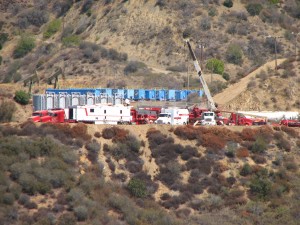Fillmore, CA – The oil industry recently completed hydraulic fracturing (“fracking”) operations for six more oil wells inside the boundary of the Los Padres National Forest, pumping thousands of gallons of potentially toxic chemicals into the ground without any public notice or environmental documentation. They are the twelfth and thirteenth oil wells to be fracked in this remote, environmentally sensitive area since June 2012, representing the highest concentration of fracking operations throughout the entire central California coast.

Sespe fracking operation underway, August 2013.
The wells are located in the Sespe Oil Field approximately six miles north of the town of Fillmore in Ventura County, and less than one mile from the boundary of the Sespe Condor Sanctuary, a 53,000-acre wildlife refuge that was established in 1947 to protect habitat for the critically endangered California condor. The area also lies within the watershed of Sespe Creek, which provides farms and communities downstream with a clean, reliable supply of water.
“The Sespe Oil Field is now ground zero for fracking in our region,” said Jeff Kuyper, executive director of Los Padres ForestWatch, a nonprofit watchdog organization that monitors oil drilling in the Los Padres National Forest. “Unfortunately, this controversial drilling technique continues to be approved in one of the most ecologically sensitive areas of the national forest, without any public notice and with few environmental safeguards in place to protect our communities’ water supplies.”
Combined, the six fracking operations in 2013 consumed nearly 4.75 million gallons of water, according to documents submitted to the California Department of Oil Gas and Geothermal Resources (DOGGR) and the FracFocus website. The fracking operations reportedly injected the following chemicals beneath the Los Padres National Forest:
- ammonium salt
- sodium hydroxide
- ammonium chloride
- ethylene glycol
- monoethanolamine borate
- acetic acid
- acetic anhydride
- methanol
- sulfonate
- 2,2 Dibromo-3-nitriloproplonamide
- 2-Monobromo-3-nitriloproplonamide
- sodium persulfate
- hemicellulase enzyme
- glutaraldehyde
- guar gum
- organic phosphonate
- ammonium chloride
- amine salts
- polyquaternary amine salt
- bentonite, benzyl (hydrogenated tallow alkyl) dimethylammonium stearate complex
- bis-quaternary methacrylamide monomer
- sodium chloride
- quaternary amine
- surfactant mixture
- silica gel
- sodium sulfate
Five of these chemicals were listed as “confidential business information” and no additional information was provided on their chemical makeup.
The fracking operations concluded just as the federal Bureau of Land Management closed its official comment period on a proposal to regulate fracking on federal lands nationwide. The BLM received more than one million comments from the public, asking the agency to strengthen its first draft of regulations. Los Padres ForestWatch joined a letter signed by 36 local and national environmental organizations calling for stricter oversight, full disclosure of all chemicals, advance public notice, and thorough environmental review for any future fracking operations.

Trucks hauling sand to the fracking site – the sand is pumped into the ground along with water and chemicals as part of the hydraulic fracturing process.
The fracking operations also coincided with the enactment of California’s first-ever law regulating the practice. On September 20, 2013, Governor Jerry Brown signed SB4, which requires the state Department of Oil, Gas and Geothermal Regulation (DOGGR) to issue regulations governing hydraulic fracturing statewide, and to conduct a study of the possible environmental impacts of fracking. Until DOGGR issues these regulations and completes the study, fracking may continue in the Los Padres National Forest without any public notice or environmental analysis.
The wells are all owned by Seneca Resources, an oil company based in Houston, Texas that operates most wells in the Sespe Oil Field. The fracking operations were conducted by Halliburton.
ForestWatch will continue to participate in statewide and federal regulatory efforts, and will demand full disclosure of fracking chemicals and adequate safeguards to protect water quality and the environment. Until these safeguards are in place, ForestWatch supports a complete moratorium on this controversial oil extraction process in the Los Padres National Forest.







Comments are closed.